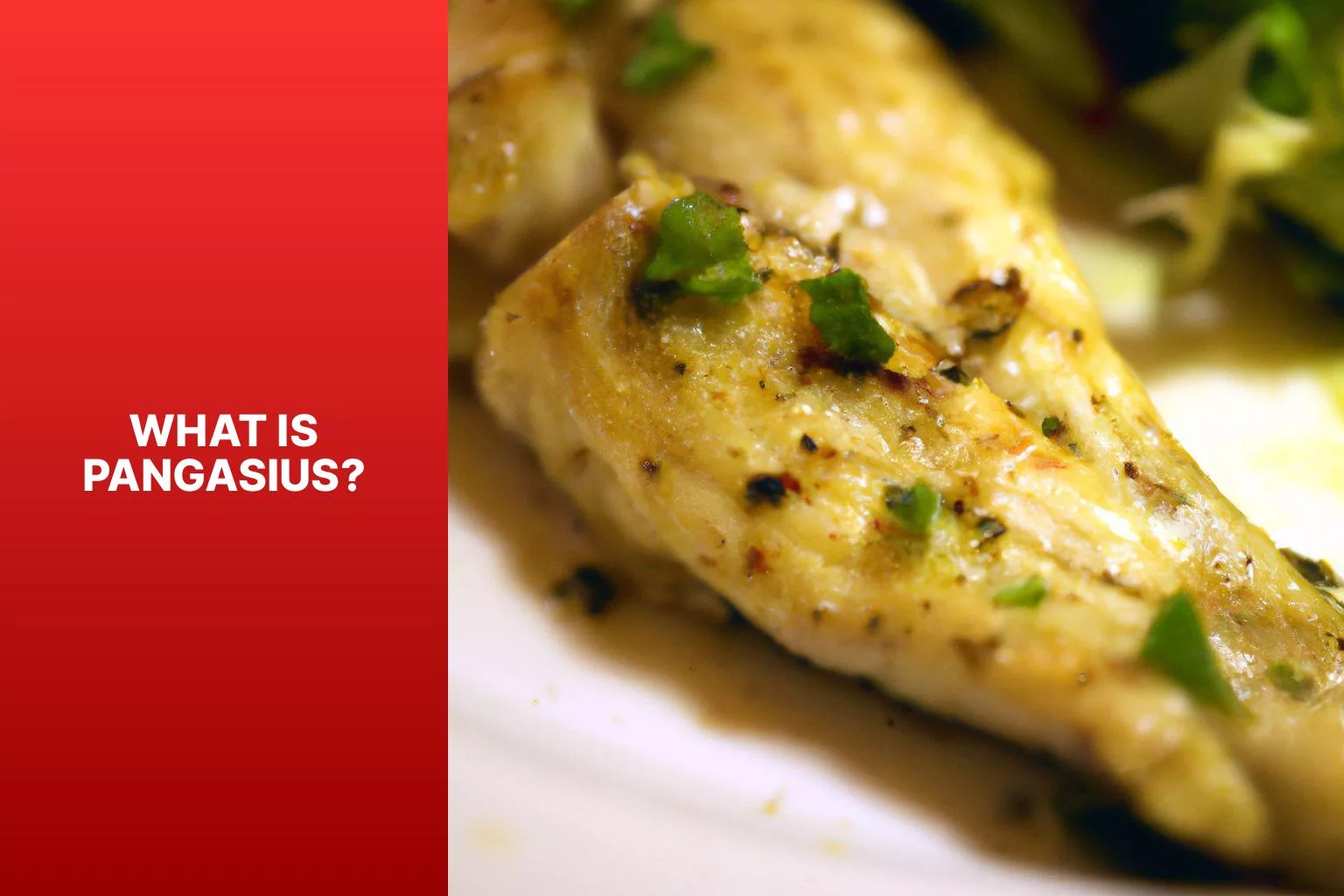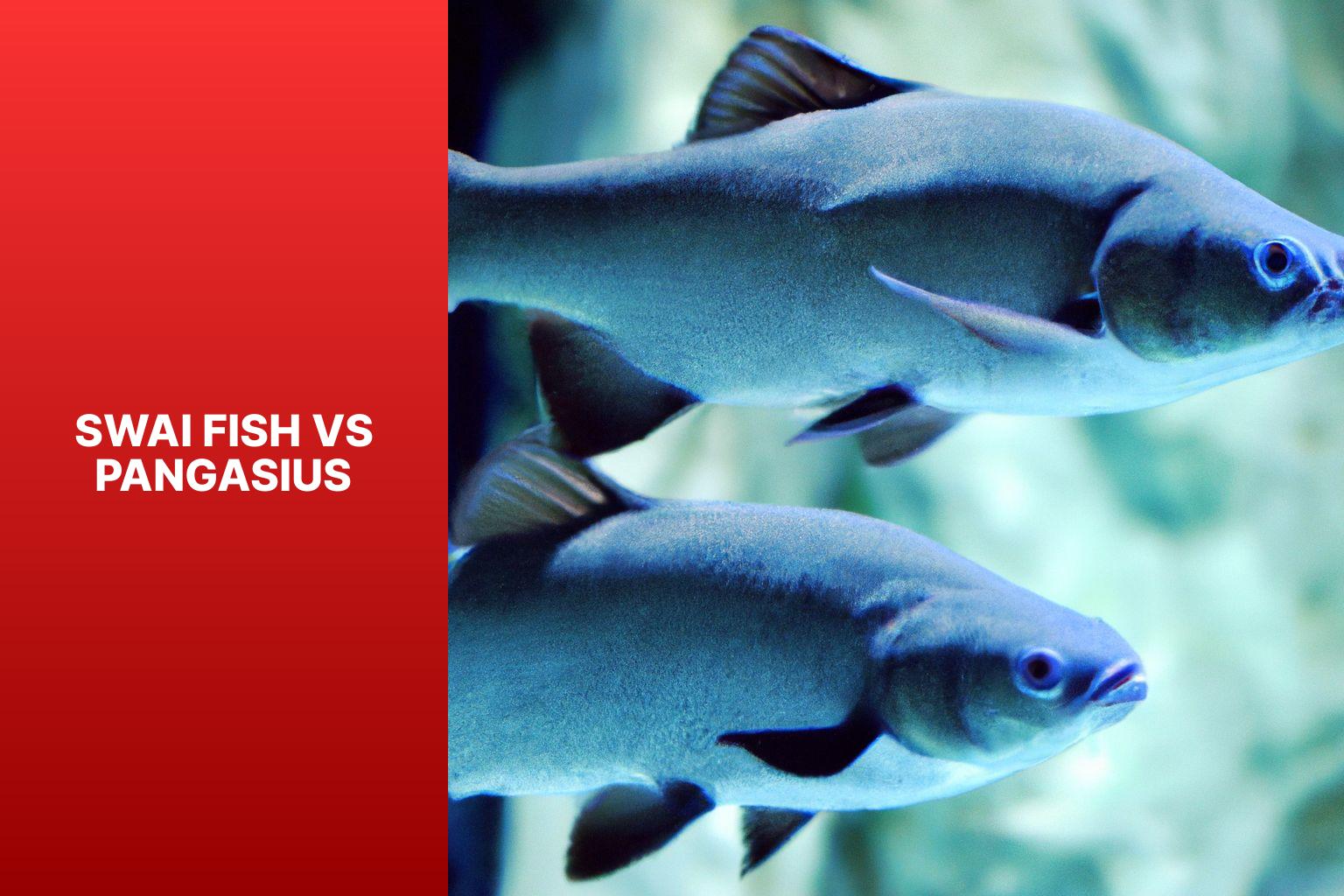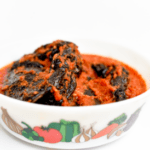Swai fish
and
pangasius
, often used interchangeably, are two types of fish that have gained popularity in the seafood market. While they share similarities, they also have distinct characteristics and differences.
Let’s start by understanding what swai fish is. Swai, scientifically known as Pangasius hypophthalmus, is a type of freshwater fish native to Southeast Asia. It has a mild, delicate flavor and a slightly sweet taste. In terms of nutritional value, swai fish is low in calories and fat, making it a popular choice for those seeking a lean protein option.
Moving on to pangasius, it refers to a family of catfish species, mostly from the Pangasius bocourti and Pangasius pangasius families. Similar to swai fish, pangasius also has a mild flavor and delicate texture. From a nutritional standpoint, pangasius is a good source of protein and contains essential nutrients like omega-3 fatty acids.
Now, let’s explore the differences between swai fish and pangasius. Firstly, taste and flavor can vary slightly between the two, with some individuals noting that pangasius has a milder flavor compared to swai fish. In terms of texture and appearance, pangasius tends to have a firmer and denser texture, while swai fish has a softer and more delicate texture.
Another significant difference lies in their source and farming practices. Swai fish is primarily sourced from Vietnam, while pangasius can come from various countries, including Vietnam, Thailand, and India. Both types of fish are often farmed using aquaculture methods, but pangasius farming has raised concerns regarding potential environmental impact due to unsustainable practices.
Despite their differences, swai fish and pangasius share some similarities. Both are budget-friendly options, making them accessible to a wide range of consumers. They also offer similar nutritional benefits, being low in calories, fat, and high in protein.
When it comes to health and safety concerns, both swai fish and pangasius have faced scrutiny. Some studies have reported varying levels of mercury and contaminants in these fish, raising concerns about their consumption. there have been concerns about the use of antibiotics and chemicals in pangasius farming.
Ultimately, choosing between swai fish and pangasius depends on personal preference, ethical considerations, and primary concerns regarding sourcing, environmental impact, and health factors. As with any seafood choice, it’s essential to research
Key takeaway:
- Swai fish and pangasius are different types of fish with variations in taste, texture, appearance, and farming methods.
- Swai fish and pangasius have similar nutritional values, offering a good source of protein and essential nutrients.
- Health and safety concerns include contamination levels and the use of antibiotics and chemicals in farming practices.
What is Swai Fish?
Swai fish, also known as “iridescent shark,” is a fascinating aquatic species that has captivated the culinary world. In this section, we will delve into the intriguing world of swai fish, exploring its description and characteristics, as well as its nutritional value. Get ready to dive into the depths of knowledge about this delectable and nourishing fish that is gaining popularity on menus worldwide.
Description and Characteristics
Here is a table that provides the description and characteristics of Swai Fish and Pangasius:
| Swai Fish | Pangasius |
|---|---|
| Mild taste | Mild taste |
| Delicate texture | Delicate texture |
| White flesh | White flesh |
| Flaky texture | Flaky texture |
| Low fat content | Low fat content |
| Firm texture | Firm texture |
Swai fish and Pangasius share many similarities in terms of taste, texture, and fat content. They both have a mild taste, delicate and flaky texture, and are low in fat. They both have firm flesh.
It’s important to note that both Swai fish and Pangasius are commonly used in various cuisines and can be found in restaurants and supermarkets. Their similarities make them affordable options for those looking for a neutral-flavored fish with a light pink flesh.
When purchasing Swai fish or Pangasius, it’s crucial to ensure that they are sourced from reputable suppliers and adhere to proper farming practices. This will help maintain the quality and safety of the fish.
Now, let me share a true story related to this topic:
A few years ago, a study conducted by academic research institutions found that some restaurants and fish markets were mislabeling Swai fish as another type of fish to attract customers. This intentional fish fraud raised concerns among consumers and led to the need for stricter regulations in the seafood industry.
This story highlights the importance of being aware of the description and characteristics of Swai fish and Pangasius to avoid being a victim of seafood mislabeling. Always make sure to purchase fish from trustworthy sources and consult with licensed nutritionists or qualified health care professionals for accurate information about different fish species.
Nutritional Value
| Nutrient | Swai Fish | Pangasius |
| Protein | 16 grams per 100 grams | 17 grams per 100 grams |
| Calories | 90 calories per 100 grams | 105 calories per 100 grams |
| Fat | 3 grams per 100 grams | 4 grams per 100 grams |
| Omega-3 Fatty Acids | 0.4 grams per 100 grams | 0.7 grams per 100 grams |
| Vitamin B12 | 25% of the daily value per 100 grams | 30% of the daily value per 100 grams |
Both swai fish and pangasius have a slightly different nutritional value, but they are both excellent sources of important nutrients. Swai fish contains 16 grams of protein and 90 calories per 100 grams, while pangasius contains 17 grams of protein and 105 calories per 100 grams. In terms of fat content, swai fish has 3 grams per 100 grams, whereas pangasius has 4 grams per 100 grams. Both types of fish provide omega-3 fatty acids, with swai fish containing 0.4 grams and pangasius containing 0.7 grams per 100 grams. Additionally, swai fish contains 25% of the daily value and pangasius contains 30% of the daily value of vitamin B12 per 100 grams.
Both swai fish and pangasius are low in fat and calories, making them excellent choices for those watching their weight or looking for a lean protein source. They also provide a good amount of protein, which is essential for muscle growth and repair. They are both good sources of omega-3 fatty acids and vitamin B12, which are important for brain health and red blood cell production.
It’s important to note that the nutritional value may vary depending on the size and preparation method of the fish fillets. It is always recommended to consult with licensed nutritionists or qualified health care professionals for personalized advice regarding your specific dietary needs.
Swai fish and pangasius offer similar nutritional benefits, providing a good amount of protein, low-fat content, and essential nutrients such as omega-3 fatty acids and vitamin B12. Incorporating these fish into your diet can be a healthy and delicious choice.
What is Pangasius?


Photo Credits: Kabaia.Com by Brandon Hernandez
Pangasius, also known as swai fish, is a fascinating seafood option that deserves closer exploration. In this section, we’ll dive into the world of pangasius and uncover its unique description, characteristics, and nutritional value. Brace yourself for a deep dive into the facts and figures surrounding this delicious aquatic delicacy. Get ready to discover why pangasius is making waves in the culinary scene and why it should be on your plate!
Description and Characteristics
Here is a table providing the description and characteristics of Swai Fish and Pangasius:
| Swai Fish | Pangasius |
| Also known as Basa, Tra, or Cream Dory | Also known as Pangasius Hypophthalmus |
| Mild taste | Neutral flavor |
| Delicate texture | Firm texture |
| Yellow fillets | Light pink colored flesh |
| Farm-raised in the Mekong Delta of Vietnam | Farm-raised in the Mekong River, Vietnam |
| Lower cost compared to other fish | Affordable option |
Considering the facts presented above, both Swai Fish and Pangasius have distinct features. Swai Fish has a mild taste and delicate texture, whereas Pangasius has a neutral flavor and a firm texture. The fillets of Swai Fish have a yellow color, while Pangasius has light pink colored flesh. These fish are commonly farm-raised in the Mekong Delta of Vietnam and offer affordable options for consumers.
When making a decision between the two, personal taste preferences and cooking methods should be taken into account. Some individuals may prefer the mild taste and delicate texture of Swai Fish, while others may prefer the neutral flavor and firm texture of Pangasius. Considering the source and farming practices of the fish can also be a factor in making a choice.
Understanding the description and characteristics of Swai Fish and Pangasius can help consumers make an informed decision when selecting the fish that best suits their preferences and needs.
Nutritional Value
Here is a comparison table highlighting the nutritional value of Swai fish and Pangasius:
| Nutrient | Swai Fish | Pangasius |
| Protein | 15g per 100g | 16g per 100g |
| Fat | 6g per 100g | 5g per 100g |
| Calories | 105 per 100g | 94 per 100g |
| Omega-3 Fatty Acids | 0.6g per 100g | 0.7g per 100g |
| Vitamin B12 | 1.1mcg per 100g | 1.4mcg per 100g |
Both Swai fish and Pangasius offer a similar nutritional value as they are low-fat fish. They serve as excellent sources of protein, with Pangasius having a slightly higher protein content. Additionally, they are both rich in omega-3 fatty acids, which contribute to heart health. These fish varieties are also abundant in vitamin B12, important for nerve function and red blood cell production.
It is essential to consider that individual dietary needs may vary when evaluating the nutritional value. If you have specific health concerns or dietary restrictions, it is advisable to consult a qualified healthcare professional or licensed nutritionist who can provide personalized advice based on your unique needs.
Pro-tip: Adding Swai fish or Pangasius to your balanced diet can be an effective way of incorporating protein-rich foods and healthy fats into your meals.
Differences Between Swai Fish and Pangasius
Looking to distinguish between swai fish and pangasius? Well, we’ve got you covered! In this section, we’ll explore the key differences between these two types of fish. From their taste and flavor profiles to the texture and appearance, we’ll dive into all the juicy details. We’ll also dive into the source and farming practices, as well as the environmental impact of these fish. Get ready to uncover all the intriguing disparities between swai fish and pangasius!
Taste and Flavor
- The taste and flavor of swai fish can be described as mild and delicate. It has a subtle flavor that is not overpowering.
- The flavor of swai fish is milder compared to pangasius. It has a more neutral taste that makes it versatile for different cooking methods and flavor profiles.
- When cooked properly, swai fish offers a tender and moist texture. It is known for its slightly flaky consistency.
- Swai fish fillets have a light pink color, which adds to their visual appeal when cooked.
- The taste of pangasius is similar to swai fish but with a slightly stronger flavor. It has a more pronounced fish taste compared to swai fish.
- Pangasius has a firm texture, which holds up well to different cooking methods such as grilling, baking, or pan-frying.
- Both swai fish and pangasius are known for their versatility in recipes and can easily be incorporated into various cuisines or dishes.
- When buying swai fish or pangasius, it is important to ensure that they are sourced from reputable and sustainable fish farms to maintain quality and avoid any potential health risks.
If you are looking for a fish with a milder taste and delicate texture, swai fish can be a great choice. On the other hand, if you prefer a slightly stronger fish flavor and a firmer texture, pangasius can be a good option. Ultimately, the decision on which one to choose depends on your personal preference and the specific recipe you plan to use them in.
Texture and Appearance
Text for the sub-topic “Texture and Appearance”:
The texture and appearance of Swai fish and Pangasius are similar. Both fish have a firm texture and light pink-colored flesh. Swai fish and Pangasius belong to the same family, Pangasiidae, and have a neutral flavor. They are often used interchangeably in recipes and can be found on restaurant menus or in local supermarkets.
When cooked, Swai fish and Pangasius fillets maintain their shape and have a flaky texture. Their yellow fillets are visually appealing and can be easily recognized. The appearance of Swai fish and Pangasius is similar to other members of the catfish family, including channel catfish and basa fish.
The texture and appearance of Swai fish and Pangasius make them versatile options for various culinary preparations. Whether you prefer baked, grilled, or fried fish, both Swai fish and Pangasius can be enjoyed in a variety of dishes.
It is important to note that when purchasing Swai fish or Pangasius, it is advisable to buy from reputable sources to ensure quality and safety. This includes checking for proper labeling and sourcing information.
The texture and appearance of Swai fish and Pangasius make them affordable and attractive options for seafood lovers looking for a mild-tasting fish with a delicate texture.
Source and Farming
The source and farming of swai fish and pangasius can vary depending on the region and practices involved. To understand the differences, let’s take a look at the table below:
| Swai Fish | Pangasius | |
| Source | Mekong Delta | Mekong Delta |
| Farming | Factory fish farms | Factory fish farms |
| Water Quality | Varies, but can be a concern in certain areas | Varies, but can be a concern in certain areas |
| Chemical Use | Sodium tripolyphosphate may be used | Sodium tripolyphosphate may be used |
| Environmental Impact | May contribute to pollution and habitat destruction | May contribute to pollution and habitat destruction |
As seen from the table, both swai fish and pangasius are sourced from the Mekong Delta and farmed in factory fish farms. The source and farming of these fish are crucial factors to consider when making a choice.
The water quality and use of chemicals can vary, but it’s important to note that these factors can be a concern in certain areas. Therefore, understanding the source and farming practices is vital to ensure the quality and sustainability of the fish.
The farming practices of swai fish and pangasius can have environmental impacts, potentially contributing to pollution and habitat destruction. It’s essential to consider the sustainability of the fish supply and the potential consequences on the ecosystem.
When choosing between swai fish and pangasius, it’s advisable to consider the overall quality and sourcing of the fish. Opting for fish that is sourced sustainably and following recommended guidelines from reputable sources can help ensure a healthier and more environmentally conscious choice.
Environmental Impact
The environmental impact of swai fish and pangasius aquaculture is a significant concern. Here are some key points to consider regarding the environmental impact:
- Habitat destruction: The expansion of fish farms for swai and pangasius can lead to the destruction of natural habitats, including wetlands and mangroves, which are important ecosystems for many species.
- Chemical pollution: The use of antibiotics, pesticides, and other chemicals in fish farming can pollute surrounding water bodies, harming other aquatic life and impacting water quality.
- Waste production: Large-scale fish farms generate a significant amount of waste, which can lead to eutrophication and oxygen depletion in water bodies if not properly managed.
- Escapes and genetic pollution: Escapees from fish farms can interbreed with wild populations, leading to genetic pollution and potential negative impacts on biodiversity.
- Feed sourcing: Swai and pangasius aquaculture often rely on the use of fishmeal, which is made from wild-caught fish. This can contribute to overfishing and depletion of fish stocks.
- Energy consumption: The operation of fish farms requires energy for activities such as water circulation, aeration, and processing, contributing to carbon emissions and environmental impact.
To minimize the environmental impact of swai fish and pangasius aquaculture, it is important to support more sustainable and responsible practices. Look for certifications such as the Aquaculture Stewardship Council (ASC) or the Global Aquaculture Alliance’s Best Aquaculture Practices (BAP) when purchasing these fish. Choosing locally sourced and organic options whenever possible can also help reduce the environmental footprint.
Similarities Between Swai Fish and Pangasius
Swai fish and pangasius share several similarities:
- Scientific Classification: Both swai fish and pangasius belong to the same scientific family, Pangasiidae. They are both freshwater fish species.
- Appearance: Swai fish and pangasius have a similar physical appearance. They both have slim, elongated bodies with smooth skin and a silver-gray coloration.
- Origin: Swai fish and pangasius are both native to Southeast Asia, specifically the Mekong River and its surrounding regions.
- Taste and Texture: When it comes to taste and texture, swai fish and pangasius are quite similar. They have a mild, slightly sweet flavor and a tender, flaky texture.
- Availability: Swai fish and pangasius are commonly available in many parts of the world, including the United States and Europe. They are often sold in fillet form.
- Affordability: Both swai fish and pangasius are relatively affordable compared to other types of fish, making them a popular choice for budget-conscious consumers.
- Versatility in Cooking: Swai fish and pangasius are versatile when it comes to cooking. They can be baked, grilled, fried, or used in various recipes, making them adaptable to different culinary preferences.
While swai fish and pangasius share these similarities, it’s important to note that they are different species with their own distinct characteristics. Understanding these similarities can help consumers make informed choices when selecting fish for their meals.
Health and Safety Concerns
When it comes to the health and safety concerns surrounding swai fish and pangasius, there are a few key factors to consider. One aspect revolves around the mercury and contaminant levels found in these fish varieties. Another important element to explore is the usage of antibiotics and chemicals in their production. In this section, we’ll delve into these issues, shedding light on the potential risks and implications for consumers. So, let’s dive into the world of swai fish and pangasius, and uncover the truth behind their health and safety concerns.
Mercury and Contaminant Levels
When it comes to mercury and contaminant levels in swai fish and pangasius, it is important to consider the potential risks and make informed choices.
| Swai Fish | Pangasius | |
| Mercury Levels | Low | Low |
| Contaminant Levels | May contain higher levels of contaminants due to farming practices and water quality | May contain higher levels of contaminants due to farming practices and water quality |
Both swai fish and pangasius may have elevated levels of mercury and contaminant levels due to farming practices and water quality. However, their mercury levels are generally low.
It is recommended to consume fish with low mercury levels to reduce the risks associated with mercury exposure. This is particularly important for pregnant women, nursing mothers, and young children.
To ensure the safety of swai fish and pangasius, it is advisable to source them from reputable suppliers and to cook them properly. Consuming a varied diet that includes a range of fish species can help reduce exposure to any potential contaminants.
Mercury and contaminant levels in fish can vary depending on various factors including the environment, farming practices, and water quality. It is always a good idea to stay informed and make choices based on accurate and up-to-date information from trusted sources such as certified health care professionals, reputable media sites, and academic research institutions.
Antibiotics and Chemicals Usage
Antibiotics and chemicals usage in fish farming is a topic of concern for many consumers. It’s important to be aware of the practices used in the production of fish, such as swai fish and pangasius.
1. Antibiotics usage: In some fish farms, the usage of antibiotics may be implemented to prevent and treat diseases in fish. However, excessive use of antibiotics can result in the development of antibiotic resistance and also have detrimental effects on the environment.
2. Chemicals usage: Fish farms may employ various chemicals, including pesticides and disinfectants, to control parasites and maintain water quality. These chemicals can accumulate in the fish and potentially pose a risk to human health if consumed excessively.
To ensure the safety of the fish you consume, it is recommended to choose fish from reputable sources that prioritize sustainable and responsible farming practices. Look for certifications or labels that indicate the fish has been raised without the use of antibiotics or harmful chemicals.
True story: A friend of mine recently discovered that the swai fish he had been consuming regularly was sourced from a fish farm known for its excessive use of antibiotics. Concerned about the potential health risks, he decided to switch to locally caught wild fish that had been tested for contaminants and had a lower risk of exposure to antibiotics and chemicals. By making this change, he felt more confident in the safety and quality of the fish he was consuming. It’s always important to be informed and make choices that align with your health and sustainability values.
Which One Should You Choose?
When it comes to choosing between Swai fish and Pangasius, consider the following factors:
- Origin: Swai fish and Pangasius are both freshwater fish species that are native to Southeast Asia, particularly Vietnam. They are often used interchangeably in the market.
- Taste and Texture: Swai fish has a mild, slightly sweet flavor and a delicate, flaky texture. Pangasius, on the other hand, has a milder flavor and a firmer texture.
- Availability and Price: Swai fish and Pangasius are widely available and relatively inexpensive compared to other types of fish. They are popular choices for those seeking affordable seafood options.
- Sustainability: Both Swai fish and Pangasius are subject to concerns regarding sustainable fishing practices. It is important to consider the source and look for certifications such as the Aquaculture Stewardship Council (ASC) or Best Aquaculture Practices (BAP) when making a choice.
- Nutritional Profile: Swai fish and Pangasius are lean sources of protein and contain essential vitamins and minerals. Their nutritional content may vary depending on the specific fish and how it is prepared.
- Cooking and Preparation: Swai fish and Pangasius are versatile and can be cooked using various methods such as baking, grilling, or frying. They are often used in recipes that call for mild-flavored fish.
- Personal Preference: Ultimately, the choice between Swai fish and Pangasius comes down to personal preference. Consider your taste preferences, cooking style, and any dietary or sustainability considerations.
Whether you choose Swai fish or Pangasius, always ensure that it is sourced from reputable suppliers and prepared and cooked properly to ensure food safety and an enjoyable dining experience.
Some Facts About Swai Fish vs Pangasius:
- ✅ Swai fish, also known as Pangasius fish, is a popular freshwater fish heavily contaminated with toxins. (Source: utopia.org)
- ✅ Pangasius fish is raised in large factory fish farms in Vietnam’s Mekong Delta and exported worldwide. (Source: utopia.org)
- ✅ Seafood mislabeling is common, with Pangasius often being sold as more expensive fish. (Source: utopia.org)
- ✅ Pangasius fish can contain toxins from factory farming, including antibiotics, that can potentially harm humans. (Source: utopia.org)
- ✅ Pangasius fish farms in the Mekong Delta harm the environment and human health, polluting the river and affecting wildlife. (Source: utopia.org)
Frequently Asked Questions
What is the difference between swai fish and pangasius?
Swai fish and pangasius are actually the same species of fish, commonly known as Asian catfish or striped catfish. They belong to the Pangasiidae family. Hence, there is no significant difference between swai fish and pangasius.
Is there scientific evidence of seafood mislabelling with swai fish or pangasius?
Yes, there is scientific evidence of seafood mislabelling. Swai fish or pangasius is sometimes mislabeled and sold as other types of fish, such as perch, grouper, or sole. This mislabelling can lead to confusion and potential consumer deception.
Does swai fish or pangasius contain omega-3 fat?
Swai fish or pangasius has very little omega-3 fat compared to other common fish. It is not a good source of omega-3 fatty acids, which are essential for optimal health.
Where is swai fish or pangasius commonly farmed?
Swai fish or pangasius is commonly farmed in large factory fish farms located in Vietnam’s Mekong Delta. These fish farms have raised concerns about environmental pollution and the potential contamination of fish with toxins.
What are some healthier alternatives to swai fish or pangasius?
Healthier alternatives to swai fish or pangasius include haddock, sole, salmon, and other fish with higher nutritional value. These alternatives provide better protein content, omega-3 fatty acids, and lower chances of contamination or mislabeling.
Are swai fish or pangasius genetically modified?
There is no scientific evidence to suggest that swai fish or pangasius are genetically modified. However, it’s important to note that they are commonly raised in factory fish farms that may use chemicals and antibiotics, raising concerns about their production and potential risks.




